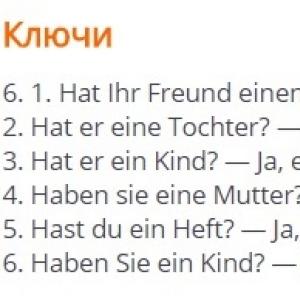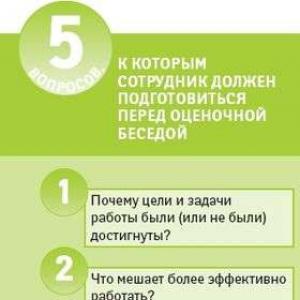What are the prepositions in Russian? Prepositions of place, time and non-derivatives. How to write prepositions correctly
Pretext is a service part of speech that expresses the dependence of nouns, numerals and pronouns on other words in phrases and sentences: I'll go To uncle, I'll go behind milk, walk By three.
Morphological features of prepositions
Prepositions connect words in phrases and sentences: go V shop, go out from shop, come in behind house.
Prepositions, like other auxiliary parts of speech, do not tend to change.
Prepositions in themselves are not members of a sentence, but are included in their composition (must be emphasized together with independent words): We got off With roads
Types of prepositions
Based on their composition, prepositions can be divided into three main groups:
1) Simple prepositions (they contain only one word with one root): at, near, above, thanks.
2) Compound prepositions (such prepositions include two or more words): despite, in contrast to, in continuation.
3) Complex prepositions (contain two roots, they must be written with a hyphen): from behind, from under, over.
Based on their origin, there are two groups of prepositions:
1) Non-derivatives (not related by formation to any part of speech): in, to, about, with, at, for, from and others. Non-derivative prepositions also include more complex ones: from behind, from under, over.
2) Derivative prepositions, by their origin, are related to other parts of speech: towards, like, about, despite.
Prepositions formed from other parts of speech are:
1) Adverbial (genetically related to adverbs): near, ahead, inside, behind etc. Such unchangeable words as in near, around, about and similar ones are also used independently (out of connection with the name), i.e. may refer to adverbs. When combined with nouns, these words become prepositions: He kept walking around Yes near (adverbs) – It was already quite late near midnight(pretext).
2) Denominative prepositions are the result of the transition of nouns into prepositions. Most often these include former nouns with prepositions: as a result of, during, in continuation of, like, in relation to, due to etc. Examples: Due to We had to wait for the next trolleybus for some delay. In continuation throughout the winter the Skvortsovs visited us two or three times a week.
3) Verbal prepositions are directly related to gerunds: in spite of, in spite of, thanks to, including, excluding, starting from, after etc. Example: On the sea, despite fog, one could admire the beautiful scenery.
Together with the article “What is a preposition in Russian?” read:
Class: 2
Lesson topic: “General concept of preposition.”
Purpose of the lesson: to introduce students to prepositions as an auxiliary part of speech.
Lesson objectives:
- Educational: expand students' knowledge about prepositions as parts of speech; his role in the Russian language; learn to write prepositions separately from other parts of speech.
- Educational: develop students’ oral and written speech, phonemic awareness, and spelling vigilance; improve students’ speech culture; develop mental processes, analytical thinking, memory, attention, the ability to self-control, the ability to follow the teacher’s verbal instructions, and draw conclusions.
- Educational: to cultivate a communicative culture among students; accuracy, perseverance, independence, discipline; to generate interest in learning the Russian language.
Equipment: multimedia slides; textbooks “Russian language. 2nd grade.” Authors: L.M.Zelenina, T.E.Khokhlova; individual cards with tasks for students; signal cards.
Participants: - 2nd grade students (9 years old).
Expected result: students’ knowledge of the preposition as a part of speech and its role in the Russian language has been expanded; Students’ ability to write prepositions separately from other parts of speech is developed. Students demonstrate the following skills: correctly use prepositions in oral and written speech; analyze the proposed tasks, find the right solutions. Students' skills in working in pairs and groups have been demonstrated; completing individual tasks. At the end of the lesson, students rated their work and the work of the class.
Lesson type: lesson in acquiring new knowledge.
Lesson Plan
- Vocabulary work.
- Setting the educational goal of the lesson (problem question).
- Step-by-step learning of new material.
- Primary consolidation. Developing skills to apply theoretical knowledge in practice.
- Secondary consolidation. Independent completion of practical tasks (work in groups).
- Checking and evaluating independent work.
- Summing up the lesson.
During the classes.
I. Organizational moment.
II. Updating students' knowledge.
B*reza, p*shield, g*leny, m*ro*, under, m*sterit, as*ts, b*stit, b*kaya, bigger. Slide 1 .
A). Spelling exercise.
- Fill in the missing letters and explain the spelling. (Chain).
- What spellings are found in the words?
b). Divide words into groups.
- Read these words again with your eyes and tell me, on what basis can these words be divided into groups?
- How many groups will there be? Which? Slide 2.
- Write the words into three groups yourself: 1st row - nouns, 2nd row - adjectives, 3rd row - verbs.
(Check by reading students from their seats and highlighting on a slide). Slide 3.
- Read the first group of words. What part of speech is this? Prove it.
- Read the second group of words. What part of speech is this? Prove it.
- Read the third group of words. What part of speech is this? Prove it.
- Show with signals who completed this task without errors.
- Which word was the odd one out? Why? Slide 4.
- Who knows what the word could be called? under ?
- Guys, while studying the alphabet, Russian language, literary reading, did we come across prepositions?
But we didn't talk about them in detail.
- Maybe someone can guess what we will talk about in class today?
PHYSICAL MINUTE
III. Working on new material.
- Announcing the topic of the lesson and setting goals.
- That's right, today we will talk about prepositions as parts of speech; learn what prepositions are needed in Russian; how they are written with other parts of speech. The topic of our lesson: “The general concept of preposition.”
2. Completing exercise No. 83, page 54 of the textbook. Slide 5.
- When answering questions, you used the words: on, under, for, to. What are their names?
- Absolutely right, these are prepositions. There are many other prepositions in Russian: on, from, by, about, from, in, at, about, with, over and many others. Slide 6.
Table 6.
- Guys, try asking a question for the prepositions. Are you able to do this?
- A preposition is a part of speech. Prepositions cannot be questioned; they do not change. Slide 7.
 Table 8.
Table 8.
- But what are prepositions used for in Russian, you will try to answer me by completing the following task.
3. Working with text.
Snowflakes are spinning in the cold air. Children ride…..skating…. ice.
Fun for kids…..winter time…. street. Slide 8.
- Read the sentences. Tell me, are the words connected in meaning?
- How to connect words in sentences? What's missing from the text?
- Let's insert prepositions.
Students write in notebooks, and students named by the teacher comment as they write.
- Is the connection between words in sentences established?
- What role do prepositions play in the Russian language?
- That's right, prepositions serve to connect words in a sentence. Therefore they are called the auxiliary part of speech. Slide 9.
 Table 9
Table 9
- Identify the parts of speech in the sentences. (Chain).
- What parts of speech are preceded by prepositions? Which part of speech has no prepositions?
- That's right, prepositions are friendly with nouns and adjectives, but prepositions are not friendly with verbs, so prepositions are not used before verbs. Slide 10.
 Table 10
Table 10



Table 11 Table 13 Table 14
(Schemes for the use of prepositions with other parts of speech).
Pay attention to how prepositions with other words are written.
- Prepositions with other parts of speech are written separately. Slide 11.
 Table 11
Table 11
- In order not to make mistakes when writing prepositions with words, you need to remember the rule: between the preposition and the word you can insert another word or question. For example:
for a tree - for a tall tree; for (what?) tree. Slide 12.
 Table 7
Table 7  Table 1
Table 1
4. Formation of the skill of writing prepositions with other parts of speech.
- Copy the text, opening the brackets. Insert suitable words between the preposition and the word. Explain writing prepositions. Slide 13.
Spring has come (to) the forest. The buds (on) the trees are swollen. Young grass comes to life (under) the snow.
Record sentences in rows, each row - one sentence.
5. Drawing up an algorithm for the lesson topic. Slide 14.
1). A preposition is a functional part of speech.
2). Prepositions do not change; questions cannot be asked about them.
3). Prepositions are used to connect words in a sentence.
4). Prepositions are not used before verbs.
5). Prepositions with other parts of speech are written separately.
6). You can insert another word or question between the preposition and the word.
PHYSICAL MINUTE (for eyes)
6. Independent work using level differentiation.
1 group. (3 people, low-performing students, working only at a productive level).
Exercise 87, page 56 of the textbook.
- Copy the tongue twister, underline the prepositions. Slide 15.
Semyon and Sanya have a catfish with a mustache in their nets.
2nd group. (6 people, students working at the reproductive-productive level).
- Combine pairs of words using prepositions. Slide 16.
Go out….. (house); go….. (forest); take care ..... (puppy)
3rd group. (4 people, students working at productive and creative levels).
- Find errors in the sentences, correct them, write the sentences correctly in your notebook. Slide 17.
A hazel grouse jumped out of the bushes along the forest path. The ball was thrown into the goal net.
(Checking by students reading the tasks is simultaneously displayed on the slide. Students use signals to show how they completed the task.) Slides 18-20.
IV. Lesson summary.
- Imagine that your friend got sick and was not at school today.
- What will you tell him about the Russian language lesson?
- So, you and I knew the parts of speech: noun, adjective, verb. Today we learned another part of speech - preposition. Slide 21, 24.
Test - survey.
On your tables are sheets of test paper on the topic of the lesson. Complete it.
- Choose the correct statement.
- Which part of speech does not have prepositions?
- How to spell words:
- Indicate the numbers in which the error was made.
- Which sentences have prepositions?
A.
A mound of yellow clay grew near the den.
A. Prepositions do not serve to connect words in a sentence.
B. Prepositions are used to connect words in a sentence.
A. Before a noun.
B. Before an adjective.
IN. Before the verb.
(with) cheerful, (on) the street, (over) cranberries?
A. Apart.
B. Together.
A. danced
B. behind the school
IN. to write
B. White snow flakes are flying to the ground.
IN. The greenery of the fir trees has faded.
Cross-check with sample. Use signals to show who completed it without errors? Who completed all the tasks incorrectly? Slide 22.
V. Homework.
Page 55 – learn the rule. Table 3
Table 3
VI. Reflection.
Today is the first day of spring. In spring, nature wakes up and comes to life. With the arrival of spring, the first spring flowers appear - snowdrops. And I would like spring to come in our class too. There are snowdrops on your desks. Take one of them and attach it to our clearing. If you liked the lesson, you are in a good mood - attach a flower that has already bloomed, if you didn’t like something, did not understand something - attach a flower that has bloomed halfway, if you did not like the lesson at all, you are in a bad mood - attach a flower that has not yet fully blossomed.
 Table 5
Table 5  Table 4
Table 4
1. Two levels of the concept of “preposition”: 1. Preposition-1 as a service part of speech; 2. Preposition-2 as a functional unit - a class that includes both prepositions themselves and their substitutes, for example, iso-functional to the actual prepositions of formation such as “in the immediate vicinity of what / from what / to what” (not having other functions except the actual prepositional; and performing the functions of a preposition in certain positions while maintaining their part-verbal affiliation with word forms such as “the size of someone or something”, etc.).
- Definition of preposition as a part of speech; specificity of the part-time
- The function of a preposition is to specify the role of the name it introduces
- Morpho-syntactic types of prepositions. Typology of prepositions:
- Prepositions and 2. Prepositional expressions are complex multi-component structures that include adjectives (on the right / left side of someone), pronouns (on that / this side of someone) or comparative adjectives-adverbs (two kilometers / two kilometers south of Moscow). Prepositions: 1) primary and 2) secondary.
- Primary prepositions: a) primitives: without, in, outside, before, etc.; and b) ambivalent prepositions-adverbs such as: past, near, etc. Some primitive prepositions control two (in / on the table - in / on the table, between / between brothers / brothers) or three cases (from home - with house - with the house, around the house - on Wednesday - at the end), which in most cases (except between / between) is due to differences in semantics. Varieties of primitive prepositions: a) single - all primitives; prepositions with negations: not without something, not to anything; c) complex or compound prepositions, consisting of two or three primitive prepositions, regardless of spelling: together (between, behind, opposite, opposite), hyphenated (because of, from under) or separately (for the sake of); complex prepositions are always monocase, that is, regardless of the quantitative composition, they control one noun. Cases are possible: both components control one form (for the sake of someone), the controlling component is the first component: from behind the house, from under the table; control component - second component: over the river; y) compound two- and three-component and, accordingly, two- and three-case structures such as from what / whom to what / whom, in how much time / what is the distance to what / whom; how many units south/north of what. Compound prepositions always control two or three nouns respectively.
- Secondary prepositions are derivatives of other parts of speech: beings
- One-component derivatives are a) simple (uncomplicated form of the original part of speech) of the order of two, thanks to you, regarding the work; b) complex - including a former preposition in the form of a prefix: due to the rain, behind the house, on top of the carpet;
- Multicomponent derivatives necessarily include either primitive prepositions or negation. The derivative can include either one primitive preposition: a) in preposition to the main word form: with the help of a knife, in view of the shore (stop), under the supervision of specialists (work); b) in the postposition: long before the start, in relation to the language, right up to the departure, following the brother; or two, constituting a frame construction relative to the original word form: in relation to a friend, depending on the weather; negation can appear without a primitive preposition: not reaching the house, not reaching the city; and in combination with the original preposition: regardless of faces, despite the rain.
- Syntax of prepositions.
- Syntagmatics of prepositions.
- The ability of the Russian preposition to attach to itself, in addition to nouns: a) quantitative, collective and fractional numerals: more than two, from three to five, for six, one tenth of a meter high; b) infinitive (some prepositions): in order to visit (the museum), in the hope of entering (the university), (- What) about having lunch?; c) adverbs: (postpone) for later; (go) to nowhere; (pass) excellent; d) interjections: (sing) with an “encore”, (pass) with a “hurray”. Pronominalization of prepositional structures. In some cases, instead of a personal pronoun: at brother - at him; - the preposition uses either the possessive: with the help of a knife - with its help; or demonstrative: as a lawyer - in this capacity. The impossibility of pronominalization in nominal prepositional groups with the meaning of time (cf.: on Wednesday - *in it) and state (cf.: in anger - *in it).
- The ability / inability of secondary compound prepositions to “let in” an agreed definition between the primitive preposition and the main word form, cf.: (to work) in conditions of oxygen deficiency - in the most difficult conditions of oxygen deficiency[§§§§§]; and: (work) as an electrical foreman - *in the important capacity of an electrical foreman; possible isofunctionality of a controlled noun and an adjective: for economic reasons - for economic reasons; by experiment - experimentally.
- Positional potential of prepositions: I live far from work - I live far from work.
183. Read it.
In a clearing near the path
Blades of grass are breaking through.
A stream runs from a hillock,
And there is snow under the tree.
(B. Zakhoder)
- What means in a clearing, by a path, from a hillock, under a tree?
- Words on, at, with, under- This prepositions. What nouns are they used with? How are prepositions with words written - together or separately?
- Write it off. Underline the prepositions.
184. Read it.
- Words to, in, at, by, without- these are prepositions. What nouns are they used with?
- Write down the prepositions from the poem along with the nouns they refer to.
- What role do prepositions play in a sentence?
There is no spring without willow.
Rain drop by drop, dew drop by dew drop.
Cranes scream - it means rain.
Summer is at the gates - look in the garden.
185. Look at the drawing. Read the prepositions.
- Read the prepositions as they are written. Now read them the way we pronounce them.
Remember writing prepositions: without, over, under, before, between, about, through, from, for and etc.
186. Read it.
1. The children were walking... in the forest. 2. In spring, birds fly... south... north, and in autumn -... north... south. 3. The swans were flying... by the sea. 4. Bread is baked... flour. 5. We read a book... animals. 6. April... with water, May... with grass.
- Which preposition (or prepositions) is missing in each sentence? Explain your choice.
- Copy by inserting the necessary prepositions. Write prepositions separately with nouns.
A prel
187. Read it. Title the text.
We saw a baby squirrel on a pine tree. The animal descended from branch to branch. He disappeared from view for a minute and suddenly, we looked, he was jumping along the ground towards a birch tree. There was a mushroom growing near the birch tree. Out of nowhere a fox appears from the grass. The little squirrel instantly disappeared into the branches. The fox was left with his nose.
(V. Bianchi)

- Who is the text talking about? Explain how you understand the meaning of the highlighted expressions.
- Find prepositions in the sentences. Write down the prepositions along with the nouns.
188. Read it. Which nouns with prepositions have their places mixed up?
- Correct the mistakes! Write the tongue twister correctly.
Sanya pulls a sleigh down the hill.
The sleigh goes up the hill on its own.
189. Read it.
1. Take care of your nose in... frost. 2. A moth flies to... a flower. 3. In... the water there is a singer frog. 4. The... dog has its own nickname. 5. Without... corners, a hut cannot be cut down. 6. A feast for... the world. 7. From... a spark and a big fire.
- Copy it by inserting between the preposition and the noun a suitable word from the words for reference.
Words for reference: all, scarlet, every, big, own, four, small.
Note!! You can insert another word between the preposition and the noun.
190. Read it.

- Remember the use of prepositions in these word combinations.
- Write down combinations of words. Orally make a sentence with one of them.
191. Read it.
I walked along a narrow path, I work in a bookstore, I came from a music school, I grew up under a tall aspen tree, I flew over the city at night, by the blue sea.
- Write combinations of words without adjectives. Underline the prepositions.
w e l
192. Read it. Make up a sentence from the words in each line.
In the morning, the hostess set out food for the ducklings.
The ducklings were afraid to approach the plate.
Scarecrow, dragonfly, them, evil.
One day, a duckling, Alyosha, came to the yard.
Suddenly a dragonfly buzzed.
She flew straight towards the plate.
The ducklings wanted to run away.
No, brave, but scared, Alyosha.
He, the dragonfly, grabbed the wing with his beak.
She forcibly escaped.
Since then, the villainess has flown into the garden, no.

- Do sentences form text? Give it a title.
- Write down the title and text.
- Which story by Boris Zhitkov do you remember?
check yourself
1. Compose a message on the topic “What I learned about the preposition as a part of speech” according to this plan:
- What is a preposition? What are prepositions used for?
- What part of speech is the preposition used with?
- How are prepositions written with words?
- Which part of speech is not preceded by a preposition?
2. Decipher the recording. Write down the sentence. Underline the prepositions in it.
PREPARED RICE FOR BORRIS SOUP RICE
3. Read it. Fill in the missing preposition in each combination of words. Write it down.
Come ____ school. Get off ____ the bus. Come ____ Siberia. Go ____ concert.
4. Read the tongue twister. Why is she interesting?
- Write it off. Find a word that means “predatory fur-bearing animal with brown shiny fur.” Underline this word. What is the meaning of another word that is written and pronounced the same way?
- Circle the prepositions.
A mink is grieving by the mountain -
Can't get to the hole.
On the mountain near the mink there is a mink -
The slide is not accessible to the mink.
(E. Veseleva)
Prepositions - Textbook on the Russian language, grade 2 (Kanakina, Goretsky)
Short description:
Not only words that have lexical meaning are parts of speech. In texts you always come across very small words - on, for, by, in. This is also part of speech. It's called "Prepositions". Without this part of speech, we would not be able to connect words. And the statements would be something like this: “I sat down at the table.” And you need, as you guessed, to say this: “I sat down at the table.” Prepositions occur only before nouns. True, if a sign of an object appears, that is, an adjective, then the preposition is transferred. For example, like this: “I sat down at the round table.” Prepositions are written with the words ALWAYS SEPARATELY. So small words oblige you to learn a new spelling. If you have a question that the word “brought in” also has “for”, but is written together, then the answer is simple. There are no prepositions before verbs. And in this word “for” is part of the word, and not a separate part of speech. This is not to say that prepositions do not mean anything. Let's take the preposition "in". It means that something is in something. But you will get acquainted with prepositions in more detail in the following classes. And in second grade you need to learn that there are prepositions in texts and you need to distinguish between them. And, of course, learn the spelling about writing prepositions separately with other words.













